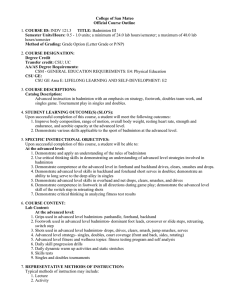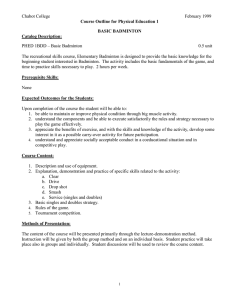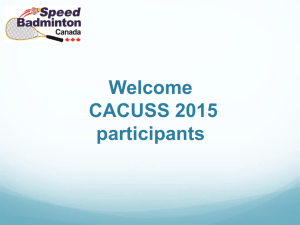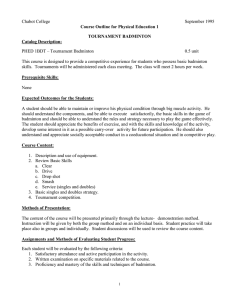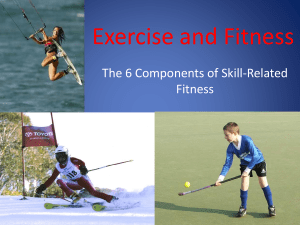College of San Mateo Official Course Outline COURSE ID: Semester Units/Hours:
advertisement
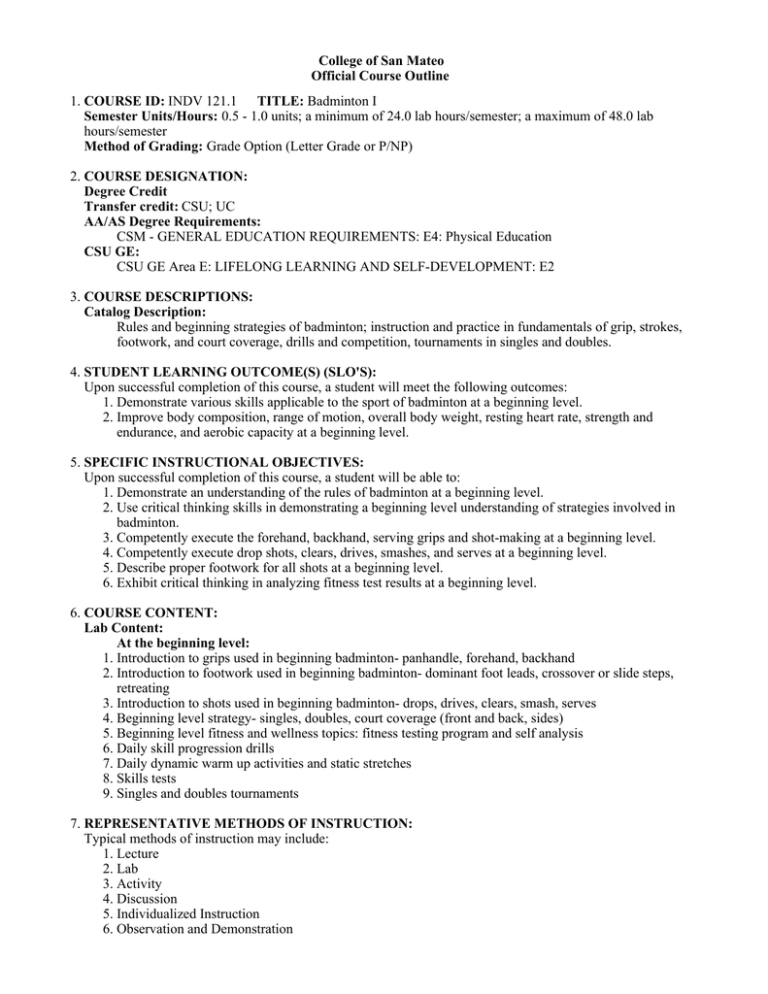
College of San Mateo Official Course Outline 1. COURSE ID: INDV 121.1 TITLE: Badminton I Semester Units/Hours: 0.5 - 1.0 units; a minimum of 24.0 lab hours/semester; a maximum of 48.0 lab hours/semester Method of Grading: Grade Option (Letter Grade or P/NP) 2. COURSE DESIGNATION: Degree Credit Transfer credit: CSU; UC AA/AS Degree Requirements: CSM - GENERAL EDUCATION REQUIREMENTS: E4: Physical Education CSU GE: CSU GE Area E: LIFELONG LEARNING AND SELF-DEVELOPMENT: E2 3. COURSE DESCRIPTIONS: Catalog Description: Rules and beginning strategies of badminton; instruction and practice in fundamentals of grip, strokes, footwork, and court coverage, drills and competition, tournaments in singles and doubles. 4. STUDENT LEARNING OUTCOME(S) (SLO'S): Upon successful completion of this course, a student will meet the following outcomes: 1. Demonstrate various skills applicable to the sport of badminton at a beginning level. 2. Improve body composition, range of motion, overall body weight, resting heart rate, strength and endurance, and aerobic capacity at a beginning level. 5. SPECIFIC INSTRUCTIONAL OBJECTIVES: Upon successful completion of this course, a student will be able to: 1. Demonstrate an understanding of the rules of badminton at a beginning level. 2. Use critical thinking skills in demonstrating a beginning level understanding of strategies involved in badminton. 3. Competently execute the forehand, backhand, serving grips and shot-making at a beginning level. 4. Competently execute drop shots, clears, drives, smashes, and serves at a beginning level. 5. Describe proper footwork for all shots at a beginning level. 6. Exhibit critical thinking in analyzing fitness test results at a beginning level. 6. COURSE CONTENT: Lab Content: At the beginning level: 1. Introduction to grips used in beginning badminton- panhandle, forehand, backhand 2. Introduction to footwork used in beginning badminton- dominant foot leads, crossover or slide steps, retreating 3. Introduction to shots used in beginning badminton- drops, drives, clears, smash, serves 4. Beginning level strategy- singles, doubles, court coverage (front and back, sides) 5. Beginning level fitness and wellness topics: fitness testing program and self analysis 6. Daily skill progression drills 7. Daily dynamic warm up activities and static stretches 8. Skills tests 9. Singles and doubles tournaments 7. REPRESENTATIVE METHODS OF INSTRUCTION: Typical methods of instruction may include: 1. Lecture 2. Lab 3. Activity 4. Discussion 5. Individualized Instruction 6. Observation and Demonstration 7. Other (Specify): Lectures, handouts and discussions on the beginning rules of badminton. Lectures, 7. Other (Specify): Lectures, handouts and discussions on the beginning rules of badminton. Lectures, handouts and demonstrations on beginning strategies in both singles and doubles play [Instructor-guided sessions using critical thinking skills to apply beginning strategy to game-situations]. Demonstrations on proper badminton grips. Demonstrations and lectures on shot-making at a beginning level (drop, clear, drive, smash, serves). Demonstrations and drills for beginning-level footwork. Lectures/discussions/handouts on fitness test and general fitness principles which will allow students to use critical thinking skills in analyzing their own results. Demonstration of warm-up and stretching activities. 8. REPRESENTATIVE ASSIGNMENTS Representative assignments in this course may include, but are not limited to the following: Writing Assignments: Comprehensive written exam on beginning-level strategies and skills. Written exam on various fitness/wellness topics Post-fitness test self-analysis of results; application of beginning-level fitness/wellness concepts to improve health Reading Assignments: Various readings from instructor-generated handouts (5-10 pages) 9. REPRESENTATIVE METHODS OF EVALUATION Representative methods of evaluation may include: 1. Class Participation 2. Class Performance 3. Exams/Tests 4. Lab Activities 5. Written examination 6. Evaluation of student participation in class discussions on beginning-level rules and strategies. Evaluation of critical thinking skills as they apply to the use of beginning-level strategy during game situations. Evaluation of student participation in daily skills enhancement drills. Evaluation of participation in warm-up and stretching. Evaluation of skills tests performance at a beginning level. Evaluation of fitness test performance and student self-analysis. Evaluation of written final examination to include students’ use of critical thinking skills as they pertain to strategy 10. REPRESENTATIVE TEXT(S): Possible textbooks include: 1. Kunar, Sunil. Badminton Skills and Rules, 2nd ed. New Delhi: KSK Publishers' Distributers, 2010 Other: 1. Instructor-generated handouts Origination Date: January 2013 Curriculum Committee Approval Date: February 2013 Effective Term: Fall 2013 Course Originator: Mikel Schmidt
